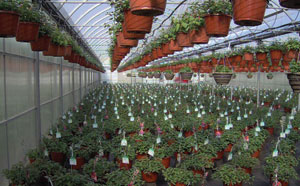3/15/2010
Baskets of Fabulous Fuchsia
Tom McKeegan and Kathy Anderson

At DeGoede Brothers, we grow many types and forms of fuchsias, from hanging baskets and standards to hardy varieties in gallon pots and small upright varieties in 6-in. and 8-in pots. We also have found them to be handy additions to mixed shade hanging baskets.
When it comes to hanging baskets, we produce roughly 38,000 of them. To grow that many—and to grow them well—we follow a tried-and-true schedule that produces a crop perfectly timed for Mother’s Day.
Planting
Use four to five pinched, rooted cuttings per 10- to 12-in. hanging basket. We prefer to use trailing or semi-trailing varieties such as Balcon Koenig, Dark Eyes, Lena or Swingtime. There are mounded varieties such as Blowick and Emma Louise that make excellent baskets, as well. Use a well-drained media, the same media you would use for any spring hanging basket.
Scheduling
A common schedule to follow for a late April or Mother’s Day flowering fuchsia would start with a mid-December planting after poinsettias are shipped. We pinch our baskets at least two times prior to hanging, and plan on pinching our baskets every three to four weeks. All pinching should be finished eight weeks prior to the desired flowering date. Chemical pinching with Florel is an option. Perform some rate trials to determine which rate is best for your crop. Using Florel to keep the plant vegetative in the winter is unnecessary as fuchsias are long-day plants and don’t produce many flower buds in the winter months.
Spacing
We hang our baskets on 24-in. staggered centers. This provides enough space to grow a large basket. One thing to consider is what to put underneath your fuchsia crop. Several lines of mature fuchsia baskets don’t let a lot of light through and that will affect the quality of the crop underneath. Once flowering, fuchsias produce an abundance of blooms and some of those flowers will end up in the crop below. At DeGoede Brothers, with more 38,000 fuchsia baskets in production, we produce additional fuchsia baskets on the ground under the lines of hanging baskets. That mix seems to work well for us.
Temperatures
Maintain a 62F (16C) heating set point and a 65F (18C) cooling set point for the day. We use a 58F (14C) night set point after planting and until we hang the baskets. Once hung, we increase our night temperature to 62F (16C) and increase the daytime cooling set point to 67F (19C). Growing fuchsias too warm can result in soft rather than the toned plants that can withstand the rigors of the shipping and retail environment.
Fertilizer and irrigation requirements
We prefer to use nitrate nitrogen-based fertilizers such as Plant Marvel 15-3-18 and 17-5-17, which we alternate along with a clear-water irrigation. Since excess nitrogen can promote vegetative growth and delay flowering, we use a rate of 200 ppm nitrogen for all our fuchsias. Allowing fuchsias to dry between irrigations during short days is important for proper growth and root development. Once hanging, and especially once the crop begins flowering, make sure the plants don’t dry out. While slight water stress is an excellent tool to promote flower bud development in March, severe water stress in April can cause flower buds to abort and lower leaf yellowing or loss.
Pests and diseases
Watch fuchsias for common pests such as aphids, mites and thrips. Use preventative fungicide drenches on a monthly rotation. Botrytis can be controlled with preventative sprays and good cultural practices.
GT
Tom McKeegan is production manager and Kathy Anderson is a grower/operations supervisor at DeGoede Brothers, LLC in Sumner, Washington.